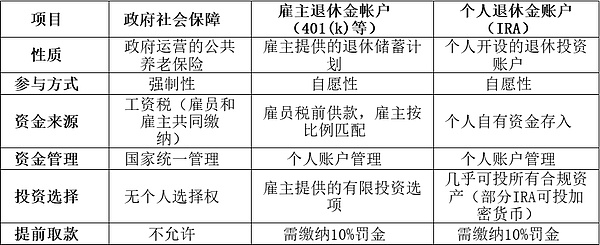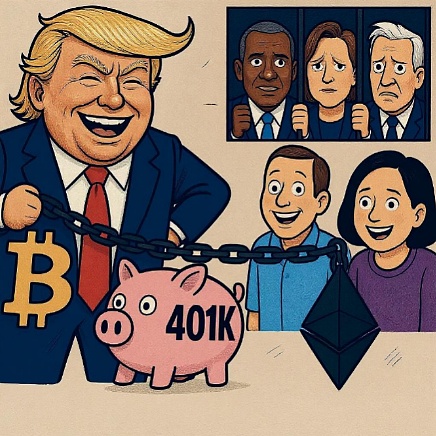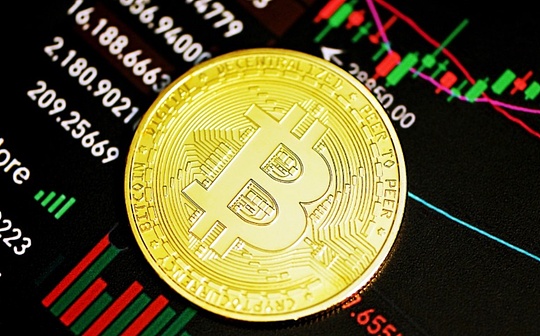
Author: Owen
Recently, US President Trump signed an executive order at the White House Democratizing Access to Alternative Assets for 401(k) Investors, requiring the Treasury Department, the Labor Department and the Securities and Exchange Commission (SEC) to initiate the revision of the rules to include “Alternative Assets” such as cryptocurrencies, real estate, private equity, etc. in the scope of 401(k) pension investment.This news is like a thunder in the ground, quickly shaking the global financial markets – it may not only leverage the pension pool of up to $8.7 trillion, but is also seen as a key step for crypto assets to move from edge trials to mainstream financial systems.
Although the White House claims that the move is intended to “expand access to diversified assets by ordinary investors”, a core question surfaces: Is this opening a new chapter in wealth appreciation for Americans’ retirement future, or is it a reckless national gamble?
1. 401(k) plan: the cornerstone of the US pension system
To understand the importance of this move, we must first understand the weight of 401(k) in the U.S. retirement security system.The pension system in the United States is composed of three pillars: the first pillar is the government-operated social security, which pays basic pensions to retirees on a monthly basis; the second pillar is the retirement savings plan provided by employers, of which 401(k) is the most popular, and funds are accumulated by employees’ pre-tax contributions and employers’ matching contributions, and employers provide limited investment options; the third pillar is the Individual Retirement Account (IRA), which is voluntarily opened by individuals, and the investment scope is wider. Some types of IRAs can already invest in cryptocurrencies.

In the second pillar, 401(k) is the most representative employer pension program, and most employers will support employee participation and accumulate funds through wage deductions and matching contributions to achieve compound interest growth.In addition to 401(k), there are also 403(b) plans for employees of public education institutions and some non-profit organizations.As of the first quarter of 2025, the US 401(k) market size has exceeded US$8.7 trillion, which is the core guarantee for the retirement life of tens of millions of American families.
Compared with mandatory government social security, the biggest difference between IRA and 401(k) as voluntary savings plans is investment autonomy: both types of accounts enjoy tax deferred or tax-free treatment, but IRA investment scope is wider and can directly hold multiple assets (including cryptocurrency allocation in some types); the investment scope of 401(k) is limited for a long time, and most funds are invested in low-risk products packaged by asset management institutions selected by employers (such as mutual funds, bonds, etc.), and do not directly hold spot assets.Trump’s reform is precisely aimed at the 401(k) investment restrictions, which creates institutional conditions for high-volatility assets such as cryptocurrencies to enter mainstream retirement portfolios.
2. From strict prohibition to release: a turning point between regulatory concepts and market reality
For a long time, the U.S. 401(k) plan strictly excludes high-risk assets such as cryptocurrencies, and the fundamental reason is to protect the security and stability of retirement savings.High volatility is naturally contrary to the goal of stable pension value-added. Regulators are worried that ordinary investors lack risk tolerance and professional judgment. Once the market fluctuates violently, it will directly impact their pension security.At the same time, financial institutions face additional costs and risks in custody, valuation and compliance, which has also prompted policy tightening to remain in a long-term trend.
The Trump administration’s signing of executive orders to relax restrictions is not a whim of policy, but a result of the superposition of multiple motives: on the one hand, it responds to the people’s demand for high-yield channels in an environment where low interest rates and high inflation coexist, and fulfills the “deregulation” promise during the campaign; on the other hand, it is the fulfillment of political capital – the crypto industry gave Trump’s support during the campaign, and its family also has investment layout in the crypto field; on the deeper background, the crypto market is no longer a marginal experiment, but is gradually regarded as a mainstream asset driven by institutional investment, approval of ETFs, and acceleration of global compliance.
It is worth noting that this policy is not only aimed at cryptocurrencies, but at the wider range of “Alternative Assets”, whose official definitions include private equity, real estate, commodities and digital currencies.This means that the original intention of the policy is to completely relax investment restrictions to expand the optional range of individual investors and cater to the society’s enthusiasm for pursuing high-yield assets.
It can be said that this turning point from “strictly prohibited” to “released” not only reflects the loosening of the US regulatory concept, but also reflects the changes in the capital market structure and the reshaping of the political ecology.
3. The impact is far-reaching: a big bet may begin
Inclusion of Alternative Assets such as cryptocurrencies into the 401(k) investment scope means that the U.S. government has launched an unprecedented high-risk trial in the retirement system.Once pensions enter the crypto market on a large scale, this will not only significantly improve market liquidity and price stability, but will also form a bundle of interests between the government and the crypto market: when the retirement savings of millions of Americans are linked to crypto assets, the government will have to consider how to maintain market stability in policy making.This deep bundling may greatly accelerate the compliance process of cryptocurrencies, forcing regulators to issue clearer and more complete regulations, thereby improving the maturity, transparency and credibility of the entire market and attracting more mainstream institutions and individual investors to enter the market.
At the same time, a deeper political consideration is that interest binding may even give crypto-friendly policies continuity across party changes.It has allowed cryptocurrencies to rise from Trump’s personal or partisan behavior to the government’s “forced choice” in protecting national property – any move to weaken the crypto market could be seen by voters as “a cheese that has moved pensions”, triggering a political rebound.

(When your pension is on the chain, do they still dare to say “no”?)
However, this gamble is full of hidden worries.The crypto market is known for its drastic price fluctuations, and its cyclical bull and bear conversion is often accompanied by substantial asset shrinkage.More importantly, there are still structural problems such as fraud, money laundering, and illegal financing lurking in the market. Some assets lack transparency, and security incidents on trading platforms occur from time to time.Once pension funds suffer heavy losses in this environment, the losses will not only be reflected in the books, but will also trigger a crisis of trust at the social level – the future security of millions of American families will be directly shaken, and political pressure will be quickly transmitted to the White House and Congress.At that time, the government may be forced to use fiscal intervention to rescue the market, forming a double kidnapping between policies and markets.
In other words, this move may not only push cryptocurrencies into an era of institutionalization and comprehensive regulation, but may also backfire policymakers when risks are out of control, making this “bold attempt” a history that has been reflected or even criticized.
4. Another perspective: the fiscal game behind tax deferral
For a long time, there have been two models in tax arrangements in the US 401(k) plan: the traditional type adopts “pre-tax investment and normal income taxed when retirement withdrawal”, and the Roth type is “after-tax investment and tax exemption when eligible for withdrawal” – and no matter which model, it has the effect of delaying taxation on investment income, which is also its long-term attractiveness.Therefore, inclusion of crypto assets in the 401(k) investment scope will not change these basic tax rules, but it means that this high-volatility asset has entered the compliance “shell” of tax deferred or tax-free for the first time, and investors can bet on the long-term growth of the crypto market while enjoying the tax advantages of their accounts.
Under this framework, fiscal impact is more like a time-based tax game.For investors who choose “traditional accounts”, current taxable income declines and government short-term tax revenues decrease, but in the future, taxable income will be included in the withdrawal stage at one time. This is a typical “water-releasing fish” strategy – using today’s concessions to exchange for a larger tax base decades later.If crypto assets succeed in the long term, the benefits cashed in at retirement may be far more than the current, thus bringing higher taxes to the government; conversely, if the market is down or the policy environment shifts, short-term tax sacrifices may lead to long-term fiscal failure.This is also the biggest risk and suspense of this move in the fiscal and taxation sense.







